CoreCLR源码探索(二) new是什么(二)
第二种new(对array的new)生成了什么机器码
我们来看一下CEE_NEWARR指令是怎样处理的,因为前面已经花了很大篇幅介绍对CEE_NEWOBJ的处理,这里仅列出不同的部分
源代码: https://github.com/dotnet/coreclr/blob/release/1.1.0/src/jit/importer.cpp#L13334
/*****************************************************************************
* Import the instr for the given basic block
*/
void Compiler::impImportBlockCode(BasicBlock* block)
{
// 省略部分代码......
// 处理CEE_NEWARR指令
case CEE_NEWARR:
// 省略部分代码......
args = gtNewArgList(op1, op2);
// 生成GT_CALL类型的节点调用帮助函数
/* Create a call to 'new' */
// Note that this only works for shared generic code because the same helper is used for all
// reference array types
op1 = gtNewHelperCallNode(info.compCompHnd->getNewArrHelper(resolvedToken.hClass), TYP_REF, 0, args);
}
我们可以看到CEE_NEWARR直接生成了GT_CALL节点,不像CEE_NEWOBJ需要进一步的转换
getNewArrHelper返回了调用的帮助函数,我们来看一下getNewArrHelper
源代码: https://github.com/dotnet/coreclr/blob/release/1.1.0/src/vm/jitinterface.cpp#L6035
/***********************************************************************/
// <REVIEW> this only works for shared generic code because all the
// helpers are actually the same. If they were different then things might
// break because the same helper would end up getting used for different but
// representation-compatible arrays (e.g. one with a default constructor
// and one without) </REVIEW>
CorInfoHelpFunc CEEInfo::getNewArrHelper (CORINFO_CLASS_HANDLE arrayClsHnd)
{
// 省略部分代码......
TypeHandle arrayType(arrayClsHnd);
result = getNewArrHelperStatic(arrayType);
// 省略部分代码......
return result;
}
再看getNewArrHelperStatic,我们可以看到一般情况下会返回CORINFO_HELP_NEWARR_1_OBJ
源代码: https://github.com/dotnet/coreclr/blob/release/1.1.0/src/vm/jitinterface.cpp#L6060
CorInfoHelpFunc CEEInfo::getNewArrHelperStatic(TypeHandle clsHnd)
{
// 省略部分代码......
if (CorTypeInfo::IsGenericVariable(elemType))
{
result = CORINFO_HELP_NEWARR_1_OBJ;
}
else if (CorTypeInfo::IsObjRef(elemType))
{
// It is an array of object refs
result = CORINFO_HELP_NEWARR_1_OBJ;
}
else
{
// These cases always must use the slow helper
// 省略部分代码......
}
return result;
{
CORINFO_HELP_NEWARR_1_OBJ对应的函数如下
源代码: https://github.com/dotnet/coreclr/blob/release/1.1.0/src/inc/jithelpers.h#L86
DYNAMICJITHELPER(CORINFO_HELP_NEWARR_1_OBJ, JIT_NewArr1,CORINFO_HELP_SIG_REG_ONLY)
可以看到对应了JIT_NewArr1这个包装给JIT调用的帮助函数
和JIT_New一样,在满足一定条件时会被替换为更快的实现
源代码: https://github.com/dotnet/coreclr/blob/release/1.1.0/src/vm/jithelpers.cpp#L3303
HCIMPL2(Object*, JIT_NewArr1, CORINFO_CLASS_HANDLE arrayTypeHnd_, INT_PTR size)
{
// 省略部分代码......
CorElementType elemType = pArrayClassRef->GetArrayElementTypeHandle().GetSignatureCorElementType();
if (CorTypeInfo::IsPrimitiveType(elemType)
{
// 省略部分代码......
// 如果类型是基元类型(int, double等)则使用更快的FastAllocatePrimitiveArray函数
newArray = FastAllocatePrimitiveArray(pArrayClassRef->GetMethodTable(), static_cast<DWORD>(size), bAllocateInLargeHeap);
}
else
{
// 省略部分代码......
// 默认使用AllocateArrayEx函数
INT32 size32 = (INT32)size;
newArray = AllocateArrayEx(typeHnd, &size32, 1);
}
// 省略部分代码......
return(OBJECTREFToObject(newArray));
}
HCIMPLEND
总结:
JIT从CEE_NEWARR只生成了一段代码,就是调用JIT_NewArr1函数的代码
第三种new(对struct的new)生成了什么机器码
这种new会在栈(stack)分配内存,所以不需要调用任何分配内存的函数
在一开始的例子中,myStruct在编译时就已经定义为一个本地变量,对本地变量的需要的内存会在函数刚进入的时候一并分配
这里我们先来看本地变量所需要的内存是怎么计算的
先看Compiler::lvaAssignVirtualFrameOffsetsToLocals
源代码: https://github.com/dotnet/coreclr/blob/release/1.1.0/src/jit/lclvars.cpp#L4863
/*****************************************************************************
* lvaAssignVirtualFrameOffsetsToLocals() : Assign virtual stack offsets to
* locals, temps, and anything else. These will all be negative offsets
* (stack grows down) relative to the virtual '0'/return address
*/
void Compiler::lvaAssignVirtualFrameOffsetsToLocals()
{
// 省略部分代码......
for (cur = 0; alloc_order[cur]; cur++)
{
// 省略部分代码......
for (lclNum = 0, varDsc = lvaTable; lclNum < lvaCount; lclNum++, varDsc++)
{
// 省略部分代码......
// Reserve the stack space for this variable
stkOffs = lvaAllocLocalAndSetVirtualOffset(lclNum, lvaLclSize(lclNum), stkOffs);
}
}
}
再看Compiler::lvaAllocLocalAndSetVirtualOffset
源代码: https://github.com/dotnet/coreclr/blob/release/1.1.0/src/jit/lclvars.cpp#L5537
int Compiler::lvaAllocLocalAndSetVirtualOffset(unsigned lclNum, unsigned size, int stkOffs)
{
// 省略部分代码......
/* Reserve space on the stack by bumping the frame size */
lvaIncrementFrameSize(size);
stkOffs -= size;
lvaTable[lclNum].lvStkOffs = stkOffs;
// 省略部分代码......
return stkOffs;
}
再看Compiler::lvaIncrementFrameSize
我们可以看到最终会加到compLclFrameSize这个变量中,这个变量就是当前函数总共需要在栈(Stack)分配的内存大小
源代码: https://github.com/dotnet/coreclr/blob/release/1.1.0/src/jit/lclvars.cpp#L3528
inline void Compiler::lvaIncrementFrameSize(unsigned size)
{
if (size > MAX_FrameSize || compLclFrameSize + size > MAX_FrameSize)
{
BADCODE("Frame size overflow");
}
compLclFrameSize += size;
}
现在来看生成机器码的代码,在栈分配内存的代码会在CodeGen::genFnProlog生成
源代码: https://github.com/dotnet/coreclr/blob/release/1.1.0/src/jit/codegencommon.cpp#L8140
void CodeGen::genFnProlog()
{
// 省略部分代码......
// ARM64和其他平台的调用时机不一样,但是参数一样
genAllocLclFrame(compiler->compLclFrameSize, initReg, &initRegZeroed, intRegState.rsCalleeRegArgMaskLiveIn);
}
再看CodeGen::genAllocLclFrame,这里就是分配栈内存的代码了,简单的rsp(esp)减去了frameSize
源代码: https://github.com/dotnet/coreclr/blob/release/1.1.0/src/jit/codegencommon.cpp#L5846
/*-----------------------------------------------------------------------------
*
* Probe the stack and allocate the local stack frame: subtract from SP.
* On ARM64, this only does the probing; allocating the frame is done when callee-saved registers are saved.
*/
void CodeGen::genAllocLclFrame(unsigned frameSize, regNumber initReg, bool* pInitRegZeroed, regMaskTP maskArgRegsLiveIn)
{
// 省略部分代码......
// sub esp, frameSize 6
inst_RV_IV(INS_sub, REG_SPBASE, frameSize, EA_PTRSIZE);
}
总结:
JIT对struct的new会生成统一在栈分配内存的代码,所以你在IL中看不到new struct的指令
调用构造函数的代码会从后面的call指令生成
第一种new(对class的new)做了什么
从上面的分析我们可以知道第一种new先调用JIT_New分配内存,然后调用构造函数
在上面JIT_New的源代码中可以看到,JIT_New内部调用了AllocateObject
先看AllocateObject函数
源代码: https://github.com/dotnet/coreclr/blob/release/1.1.0/src/vm/gchelpers.cpp#L931
// AllocateObject will throw OutOfMemoryException so don't need to check
// for NULL return value from it.
OBJECTREF AllocateObject(MethodTable *pMT
#ifdef FEATURE_COMINTEROP
, bool fHandleCom
#endif
)
{
// 省略部分代码......
Object *orObject = NULL;
// 如果类型有重要的析构函数,预编译所有相关的函数(详细可以搜索CER)
// 同一个类型只会处理一次
if (pMT->HasCriticalFinalizer())
PrepareCriticalFinalizerObject(pMT);
// 省略部分代码......
DWORD baseSize = pMT->GetBaseSize();
// 调用gc的帮助函数分配内存,如果需要向8对齐则调用AllocAlign8,否则调用Alloc
if (pMT->RequiresAlign8())
{
// 省略部分代码......
orObject = (Object *) AllocAlign8(baseSize,
pMT->HasFinalizer(),
pMT->ContainsPointers(),
pMT->IsValueType());
}
else
{
orObject = (Object *) Alloc(baseSize,
pMT->HasFinalizer(),
pMT->ContainsPointers());
}
// 检查同步块索引(SyncBlock)是否为0
// verify zero'd memory (at least for sync block)
_ASSERTE( orObject->HasEmptySyncBlockInfo() );
// 设置类型信息(MethodTable)
if ((baseSize >= LARGE_OBJECT_SIZE))
{
orObject->SetMethodTableForLargeObject(pMT);
GCHeap::GetGCHeap()->PublishObject((BYTE*)orObject);
}
else
{
orObject->SetMethodTable(pMT);
}
// 省略部分代码......
return UNCHECKED_OBJECTREF_TO_OBJECTREF(oref);
}
再看Alloc函数
源代码:
// There are only three ways to get into allocate an object.
// * Call optimized helpers that were generated on the fly. This is how JIT compiled code does most
// allocations, however they fall back code:Alloc, when for all but the most common code paths. These
// helpers are NOT used if profiler has asked to track GC allocation (see code:TrackAllocations)
// * Call code:Alloc - When the jit helpers fall back, or we do allocations within the runtime code
// itself, we ultimately call here.
// * Call code:AllocLHeap - Used very rarely to force allocation to be on the large object heap.
//
// While this is a choke point into allocating an object, it is primitive (it does not want to know about
// MethodTable and thus does not initialize that poitner. It also does not know if the object is finalizable
// or contains pointers. Thus we quickly wrap this function in more user-friendly ones that know about
// MethodTables etc. (see code:FastAllocatePrimitiveArray code:AllocateArrayEx code:AllocateObject)
//
// You can get an exhaustive list of code sites that allocate GC objects by finding all calls to
// code:ProfilerObjectAllocatedCallback (since the profiler has to hook them all).
inline Object* Alloc(size_t size, BOOL bFinalize, BOOL bContainsPointers )
{
// 省略部分代码......
// We don't want to throw an SO during the GC, so make sure we have plenty
// of stack before calling in.
INTERIOR_STACK_PROBE_FOR(GetThread(), static_cast<unsigned>(DEFAULT_ENTRY_PROBE_AMOUNT * 1.5));
if (GCHeapUtilities::UseAllocationContexts())
retVal = GCHeapUtilities::GetGCHeap()->Alloc(GetThreadAllocContext(), size, flags);
else
retVal = GCHeapUtilities::GetGCHeap()->Alloc(size, flags);
if (!retVal)
{
ThrowOutOfMemory();
}
END_INTERIOR_STACK_PROBE;
return retVal;
}
总结:
第一种new做的事情主要有
- 调用JIT_New
- 从GCHeap中申请一块内存
- 设置类型信息(MethodTable)
- 同步块索引默认为0,不需要设置
- 调用构造函数
第二种new(对array的new)做了什么
第二种new只调用了JIT_NewArr1,从上面JIT_NewArr1的源代码可以看到
如果元素的类型是基元类型(int, double等)则会调用FastAllocatePrimitiveArray,否则会调用AllocateArrayEx
先看FastAllocatePrimitiveArray函数
源代码: https://github.com/dotnet/coreclr/blob/release/1.1.0/src/vm/gchelpers.cpp#L563
/*
* Allocates a single dimensional array of primitive types.
*/
OBJECTREF FastAllocatePrimitiveArray(MethodTable* pMT, DWORD cElements, BOOL bAllocateInLargeHeap)
{
// 省略部分代码......
// 检查元素数量不能大于一个硬性限制
SIZE_T componentSize = pMT->GetComponentSize();
if (cElements > MaxArrayLength(componentSize))
ThrowOutOfMemory();
// 检查总大小不能溢出
S_SIZE_T safeTotalSize = S_SIZE_T(cElements) * S_SIZE_T(componentSize) + S_SIZE_T(pMT->GetBaseSize());
if (safeTotalSize.IsOverflow())
ThrowOutOfMemory();
size_t totalSize = safeTotalSize.Value();
// 省略部分代码......
// 调用gc的帮助函数分配内存
ArrayBase* orObject;
if (bAllocateInLargeHeap)
{
orObject = (ArrayBase*) AllocLHeap(totalSize, FALSE, FALSE);
}
else
{
ArrayTypeDesc *pArrayR8TypeDesc = g_pPredefinedArrayTypes[ELEMENT_TYPE_R8];
if (DATA_ALIGNMENT < sizeof(double) && pArrayR8TypeDesc != NULL && pMT == pArrayR8TypeDesc->GetMethodTable() && totalSize < LARGE_OBJECT_SIZE - MIN_OBJECT_SIZE)
{
// Creation of an array of doubles, not in the large object heap.
// We want to align the doubles to 8 byte boundaries, but the GC gives us pointers aligned
// to 4 bytes only (on 32 bit platforms). To align, we ask for 12 bytes more to fill with a
// dummy object.
// If the GC gives us a 8 byte aligned address, we use it for the array and place the dummy
// object after the array, otherwise we put the dummy object first, shifting the base of
// the array to an 8 byte aligned address.
// Note: on 64 bit platforms, the GC always returns 8 byte aligned addresses, and we don't
// execute this code because DATA_ALIGNMENT < sizeof(double) is false.
_ASSERTE(DATA_ALIGNMENT == sizeof(double)/2);
_ASSERTE((MIN_OBJECT_SIZE % sizeof(double)) == DATA_ALIGNMENT); // used to change alignment
_ASSERTE(pMT->GetComponentSize() == sizeof(double));
_ASSERTE(g_pObjectClass->GetBaseSize() == MIN_OBJECT_SIZE);
_ASSERTE(totalSize < totalSize + MIN_OBJECT_SIZE);
orObject = (ArrayBase*) Alloc(totalSize + MIN_OBJECT_SIZE, FALSE, FALSE);
Object *orDummyObject;
if((size_t)orObject % sizeof(double))
{
orDummyObject = orObject;
orObject = (ArrayBase*) ((size_t)orObject + MIN_OBJECT_SIZE);
}
else
{
orDummyObject = (Object*) ((size_t)orObject + totalSize);
}
_ASSERTE(((size_t)orObject % sizeof(double)) == 0);
orDummyObject->SetMethodTable(g_pObjectClass);
}
else
{
orObject = (ArrayBase*) Alloc(totalSize, FALSE, FALSE);
bPublish = (totalSize >= LARGE_OBJECT_SIZE);
}
}
// 设置类型信息(MethodTable)
// Initialize Object
orObject->SetMethodTable( pMT );
_ASSERTE(orObject->GetMethodTable() != NULL);
// 设置数组长度
orObject->m_NumComponents = cElements;
// 省略部分代码......
return( ObjectToOBJECTREF((Object*)orObject) );
}
再看AllocateArrayEx函数,这个函数比起上面的函数多出了对多维数组的处理
JIT_NewArr1调用AllocateArrayEx时传了3个参数,剩下2个参数是可选参数
源代码: https://github.com/dotnet/coreclr/blob/release/1.1.0/src/vm/gchelpers.cpp#L282
// Handles arrays of arbitrary dimensions
//
// If dwNumArgs is set to greater than 1 for a SZARRAY this function will recursively
// allocate sub-arrays and fill them in.
//
// For arrays with lower bounds, pBounds is <lower bound 1>, <count 1>, <lower bound 2>, ...
OBJECTREF AllocateArrayEx(TypeHandle arrayType, INT32 *pArgs, DWORD dwNumArgs, BOOL bAllocateInLargeHeap
DEBUG_ARG(BOOL bDontSetAppDomain))
{
// 省略部分代码......
ArrayBase * orArray = NULL;
// 省略部分代码......
// 调用gc的帮助函数分配内存
if (bAllocateInLargeHeap)
{
orArray = (ArrayBase *) AllocLHeap(totalSize, FALSE, pArrayMT->ContainsPointers());
// 设置类型信息(MethodTable)
orArray->SetMethodTableForLargeObject(pArrayMT);
}
else
{
#ifdef FEATURE_64BIT_ALIGNMENT
MethodTable *pElementMT = arrayDesc->GetTypeParam().GetMethodTable();
if (pElementMT->RequiresAlign8() && pElementMT->IsValueType())
{
// This platform requires that certain fields are 8-byte aligned (and the runtime doesn't provide
// this guarantee implicitly, e.g. on 32-bit platforms). Since it's the array payload, not the
// header that requires alignment we need to be careful. However it just so happens that all the
// cases we care about (single and multi-dim arrays of value types) have an even number of DWORDs
// in their headers so the alignment requirements for the header and the payload are the same.
_ASSERTE(((pArrayMT->GetBaseSize() - SIZEOF_OBJHEADER) & 7) == 0);
orArray = (ArrayBase *) AllocAlign8(totalSize, FALSE, pArrayMT->ContainsPointers(), FALSE);
}
else
#endif
{
orArray = (ArrayBase *) Alloc(totalSize, FALSE, pArrayMT->ContainsPointers());
}
// 设置类型信息(MethodTable)
orArray->SetMethodTable(pArrayMT);
}
// 设置数组长度
// Initialize Object
orArray->m_NumComponents = cElements;
// 省略部分代码......
return ObjectToOBJECTREF((Object *) orArray);
}
总结:
第二种new做的事情主要有
- 调用JIT_NewArr1
- 从GCHeap中申请一块内存
- 设置类型信息(MethodTable)
- 设置数组长度(m_NumComponents)
- 不会调用构造函数,所以所有内容都会为0(所有成员都会为默认值)
第三种new(对struct的new)做了什么
对struct的new不会从GCHeap申请内存,也不会设置类型信息(MethodTable),所以可以直接进入总结
总结:
第三种new做的事情主要有
- 在进入函数时统一从栈(Stack)分配内存
- 分配的内存不会包含同步块索引(SyncBlock)和类型信息(MethodTable)
- 调用构造函数
验证第一种new(对class的new)
打开VS反汇编和内存窗口,让我们来看看第一种new实际做了什么事情
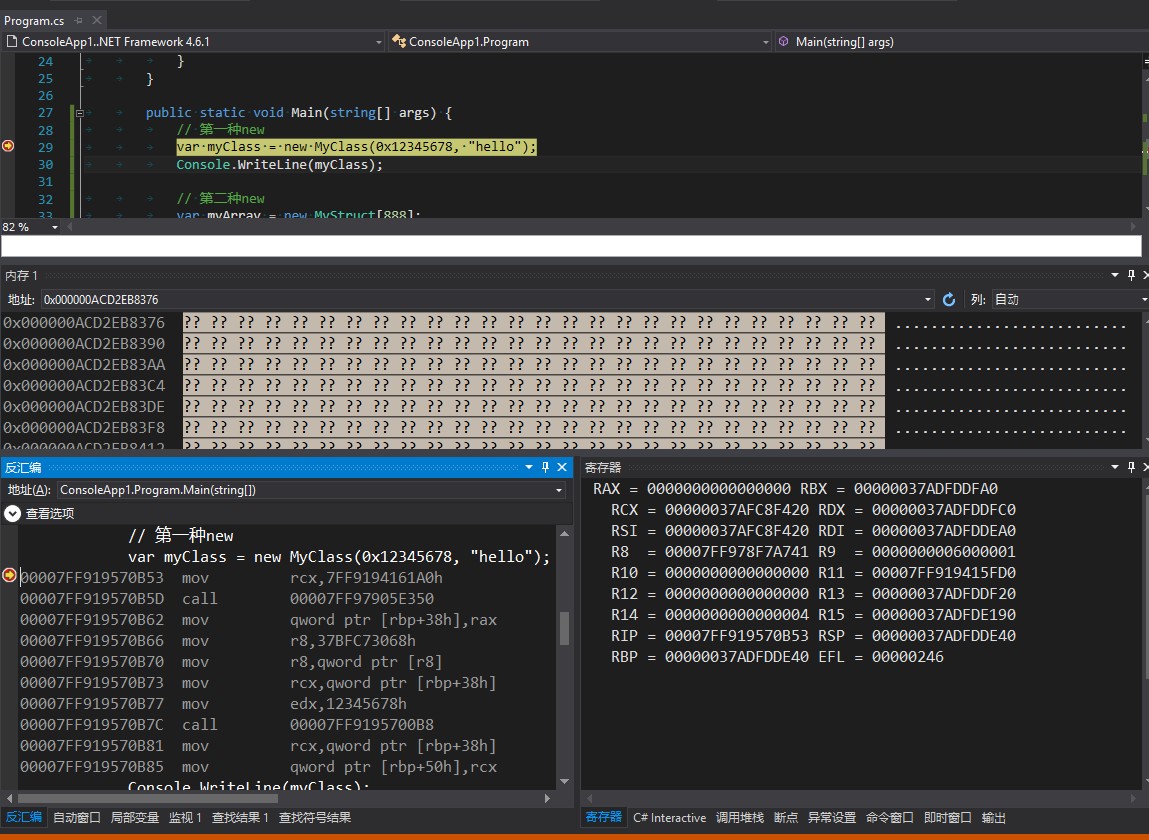
第一种new的反汇编结果如下,一共有两个call
00007FF919570B53 mov rcx,7FF9194161A0h // 设置第一个参数(指向MethodTable的指针)
00007FF919570B5D call 00007FF97905E350 // 调用分配内存的函数,默认是JIT_New
00007FF919570B62 mov qword ptr [rbp+38h],rax // 把地址设置到临时变量(rbp+38)
00007FF919570B66 mov r8,37BFC73068h
00007FF919570B70 mov r8,qword ptr [r8] // 设置第三个参数("hello")
00007FF919570B73 mov rcx,qword ptr [rbp+38h] // 设置第一个参数(this)
00007FF919570B77 mov edx,12345678h // 设置第二个参数(0x12345678)
00007FF919570B7C call 00007FF9195700B8 // 调用构造函数
00007FF919570B81 mov rcx,qword ptr [rbp+38h]
00007FF919570B85 mov qword ptr [rbp+50h],rcx // 把临时变量复制到myClass变量中
第一个call是分配内存使用的帮助函数,默认调用JIT_New
但是这里实际调用的不是JIT_New而是JIT_TrialAllocSFastMP_InlineGetThread函数,这是一个优化版本允许分配上下文中快速分配内存
我们来看一下JIT_TrialAllocSFastMP_InlineGetThread函数的定义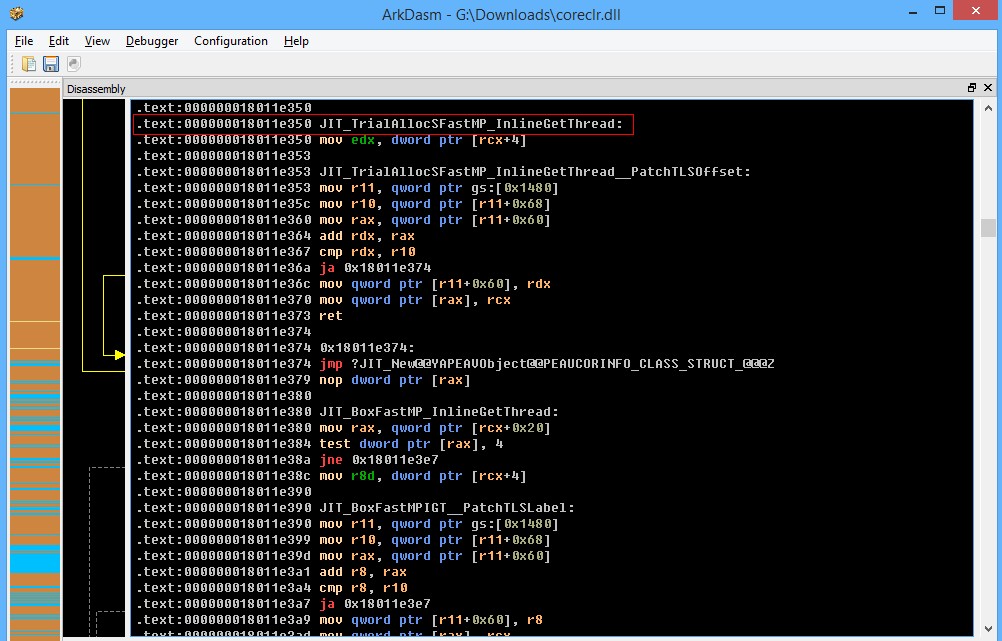
源代码: https://github.com/dotnet/coreclr/blob/release/1.1.0/src/vm/amd64/JitHelpers_InlineGetThread.asm#L59
; IN: rcx: MethodTable*
; OUT: rax: new object
LEAF_ENTRY JIT_TrialAllocSFastMP_InlineGetThread, _TEXT
mov edx, [rcx + OFFSET__MethodTable__m_BaseSize] // 从MethodTable获取需要分配的内存大小,放到edx
; m_BaseSize is guaranteed to be a multiple of 8.
PATCHABLE_INLINE_GETTHREAD r11, JIT_TrialAllocSFastMP_InlineGetThread__PatchTLSOffset
mov r10, [r11 + OFFSET__Thread__m_alloc_context__alloc_limit] // 获取分配上下文的限制地址,放到r10
mov rax, [r11 + OFFSET__Thread__m_alloc_context__alloc_ptr] // 获取分配上下文的当前地址,放到rax
add rdx, rax // 地址 + 需要分配的内存大小,放到rdx
cmp rdx, r10 // 判断是否可以从分配上下文分配内存
ja AllocFailed // if (rdx > r10)
mov [r11 + OFFSET__Thread__m_alloc_context__alloc_ptr], rdx // 设置新的当前地址
mov [rax], rcx // 给刚刚分配到的内存设置MethodTable
ifdef _DEBUG
call DEBUG_TrialAllocSetAppDomain_NoScratchArea
endif ; _DEBUG
ret // 分配成功,返回
AllocFailed:
jmp JIT_NEW // 分配失败,调用默认的JIT_New函数
LEAF_END JIT_TrialAllocSFastMP_InlineGetThread, _TEXT
可以当分配上下文未用完时会从分配上下文中分配,但用完时会调用JIT_New做更多的处理
第二个call调用构造函数,call的地址和下面的地址不一致可能是因为中间有一层包装,目前还未解明包装中的处理
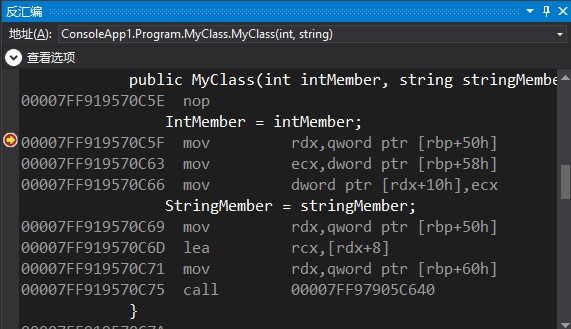
最后一个call调用的是JIT_WriteBarrier
验证第二种new(对array的new)
反汇编可以看到第二种new只有一个call
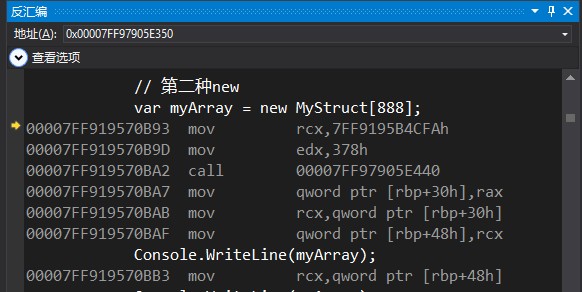
00007FF919570B93 mov rcx,7FF9195B4CFAh // 设置第一个参数(指向MethodTable的指针)
00007FF919570B9D mov edx,378h // 设置第二个参数(数组的大小)
00007FF919570BA2 call 00007FF97905E440 // 调用分配内存的函数,默认是JIT_NewArr1
00007FF919570BA7 mov qword ptr [rbp+30h],rax // 设置到临时变量(rbp+30)
00007FF919570BAB mov rcx,qword ptr [rbp+30h]
00007FF919570BAF mov qword ptr [rbp+48h],rcx // 把临时变量复制到myArray变量中
call实际调用的是JIT_NewArr1VC_MP_InlineGetThread这个函数
和JIT_TrialAllocSFastMP_InlineGetThread一样,同样是从分配上下文中快速分配内存的函数
源代码: https://github.com/dotnet/coreclr/blob/release/1.1.0/src/vm/amd64/JitHelpers_InlineGetThread.asm#L207
具体代码这里就不再分析,有兴趣的可以去阅读上面的源代码
验证第三种new(对struct的new)
对struct的new会在函数进入的时候从栈分配内存,这里是减少rsp寄存器(栈顶)的值
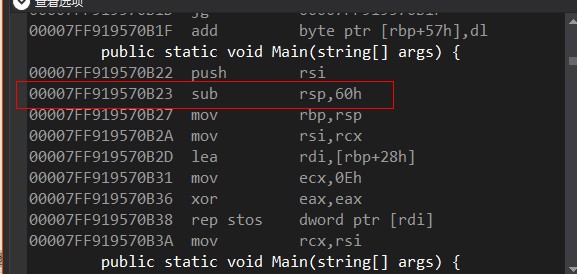
00007FF919570B22 push rsi // 保存原rsi
00007FF919570B23 sub rsp,60h // 从栈分配内存
00007FF919570B27 mov rbp,rsp // 复制值到rbp
00007FF919570B2A mov rsi,rcx // 保存原rcx到rsi
00007FF919570B2D lea rdi,[rbp+28h] // rdi = rbp+28,有28个字节需要清零
00007FF919570B31 mov ecx,0Eh // rcx = 14 (计数)
00007FF919570B36 xor eax,eax // eax = 0
00007FF919570B38 rep stos dword ptr [rdi] // 把eax的值(short)设置到rdi直到rcx为0,总共清空14*2=28个字节
00007FF919570B3A mov rcx,rsi // 恢复原rcx
因为分配的内存已经在栈里面,后面只需要直接调构造函数

00007FF919570BBD lea rcx,[rbp+40h] // 第一个参数 (this)
00007FF919570BC1 mov edx,55667788h // 第二个参数 (0x55667788)
00007FF919570BC6 call 00007FF9195700A0 // 调用构造函数
构造函数的反编译
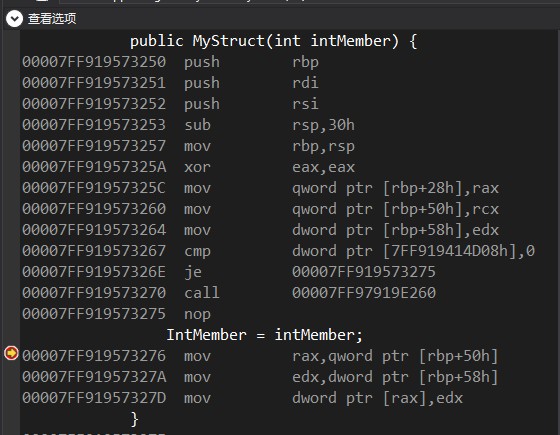
中间有一个call 00007FF97942E260调用的是JIT_DbgIsJustMyCode
在函数结束时会自动释放从栈分配的内存,在最后会让rsp = rbp + 0x60,这样rsp就恢复原值了
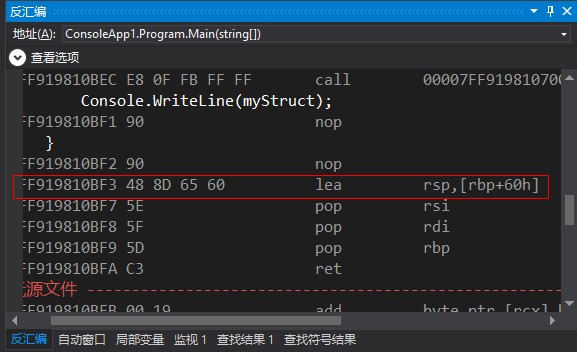
如果您发现该资源为电子书等存在侵权的资源或对该资源描述不正确等,可点击“私信”按钮向作者进行反馈;如作者无回复可进行平台仲裁,我们会在第一时间进行处理!
- 最近热门资源
- 银河麒麟桌面操作系统备份用户数据 125
- 统信桌面专业版【全盘安装UOS系统】介绍 120
- 银河麒麟桌面操作系统安装佳能打印机驱动方法 111
- 银河麒麟桌面操作系统 V10-SP1用户密码修改 105









